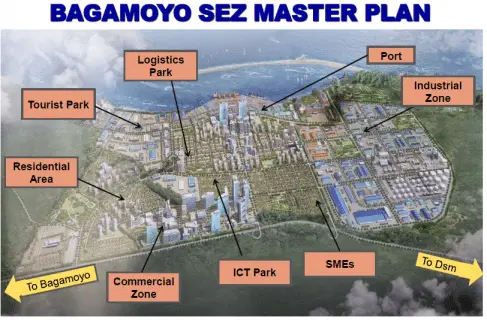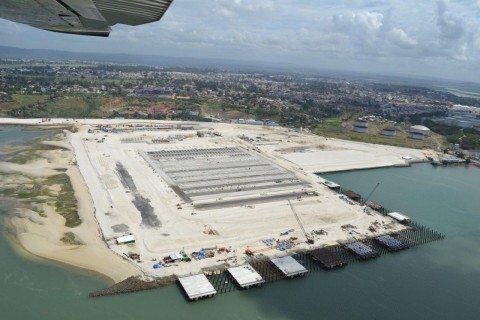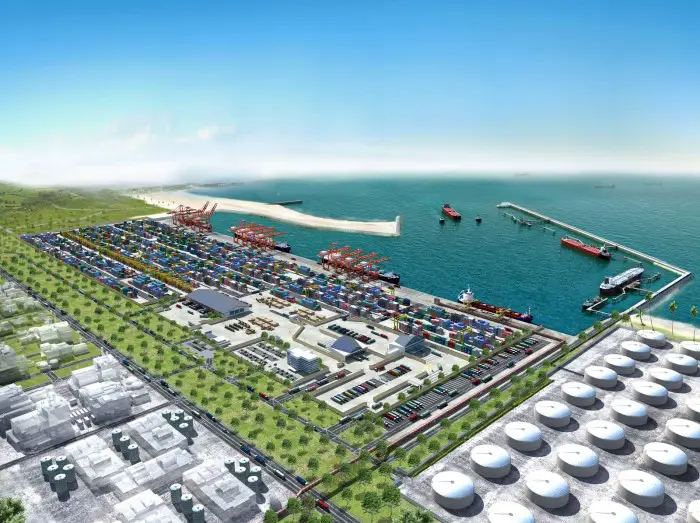Facing expansion headwinds
Compared to the volumes recorded at the dominating port terminals across the world, Africa’s leading regional port terminals lag way beyond – the Abidjan, Côte d’Ivoire; Dar es Salaam, Tanzania; Djibouti, Djibouti; Durban, South Africa; and Mombasa, Kenya do not appear to be major hubs on the world’s map because they record low capacities in regard to storage, maintenance and dredging capability.
“The steady increase in ship sizes in addition to growing cargo volumes has put pressure on cargo infrastructure and terminal capacities the world over, (and) in particular for African ports which have capacity constraints and poor transport infrastructure connectivity,” Danson Mungatana, the Kenya Ports Authority Chairman told a two-day East Africa Transport Infrastructure Conference held in Nairobi last August. Most African ports are characterized by inadequate infrastructure, poor harbor maintenance and insecurity, which puts African ports out of the list of top world’s seaports.
Capacity constraints
In a US-Africa Infrastructure Conference held in Washington, D.C in October last year by the Corporate Council on Africa, Vivienne Sequeira, the council’s Director of Infrastructure said “most of the ports are at full capacity” and most panelists raised an alarm about long delays at the ports. This situation if not addressed urgently is likely to become worse since according to the African Development Bank, port throughput in Africa will rise from 265 million tonnes in 2009 to more than 2 billion tonnes in 2040, while transport volumes will increase six- to eightfold, with a particularly strong increase of up to 14 times for some landlocked countries.
When you consider that commodities entering Africa from the rest of world come by ship the current port infrastructure’s inadequacy to meet demand is of great concern and this has spurred African governments to undertake massive seaport terminals, canal and gateway construction projects in response.
Though most shipping port activity is concentrated in Egypt and South Africa, the East and West coasts of Africa do have a number of sea ports but capacity and efficiency is still a major concern in Nigeria, Ivory Coast and Ghana.
Competition for the position of preferred maritime gateway in East Africa has pitted Dar es Salaam Port in Tanzania against the Mombasa port in Kenya. Congestion at the Mombasa Port has at times caused some shippers to go to Dar es Salaam Port which is now unfortunately congested and is not efficient due to clearing issues at the custom. While the planned Standard Gauge Railway that runs from Kenya to Uganda, Rwanda and Burundi could improve the situation, it is also necessary to have the ports expanded.
In the South of Africa, ports suffer from insufficient storage spaces and long container dwell time according to the Port Management Association of Eastern & Southern Africa (PMAESA), which is a regional grouping of ports in the two regions. PMAESA also adds that the ports continue to experience increased traffic and are not well served by access infrastructure.
Headwinds
Critics warn on a number of issues that must be observed in order to realize expected benefits on expansion of facilities. Of the most damaging would be misplacement of priorities where projects would be undertaken but fail to achieve benefits because other projects would have been better suited instead. In addition with massive expansion of ports comes the need for government to invest additional funds to develop surrounding infrastructure.
Following massive developments that have come with the new Lekki port in Nigeria for instance experts warn that the government will face environmental problems as a result of population explosion around the area if infrastructure surrounding Lekki port such as roads are not expanded within coming two years. Egypt is also warming for a larger Suez Canal, in a massive expansion drive that will cost the exchequer US$4bn.
Nigerian Ports Authority (NPA) Senior Staff Association of Communication, Corporation and Transport (SSACCTAC) has warned that deep port construction projects being undertaken across the country could be ‘wasteful ventures and jumbo projects’ and instead said that what the country needed to do was to connect existing ports to railway networks. “We don’t need any other ports, apart from the deep sea port in Lekki, rather, we need to connect the ports to rail systems so that cargo can be evacuated on time,” President of SSASTAC, NPA branch, Comrade Omeiza Jimoh Umar has said.
Kenya’s own Lamu port project may have its own issues as Tanzania and other countries have initiated similar projects. Competition among countries in regard to port activity is a reality that will dawn and may lead to low activity in some ports in the long run.
Projects such as construction of Bagamoyo Port and the Mtwara port project may not be good news since Tanzania and Kenya through the Mombasa Port have been serving the same landlocked countries. Kenya has been recording lower volumes from Rwanda and Burundi, while Tanzania has been recording improved volumes with time. Despite lower charges at the Mombasa Port, a survey in August last year revealed that expensive rail transport made the overall transportation of goods from Mombasa Port more expensive than transporting goods from Dar Port.

“Tanzania and Kenya are serving the same landlocked countries,” Janeth Ruzangi, manager of corporate communications for the Tanzania Ports Authority has said. “Firms are going to choose to use the facilities that will handle the goods with the most speed. It is natural that we have to work towards improving our port in order to attract these firms.” However, Kenya is seeking to counter the stiff competition by construction of deep berths at the Lamu Port but delays still continue to be a stumbling block.
Kenya’s ports are likely to loose further business from landlocked countries as Rwanda has partnered with Djibouti to facilitate the latter’s use of Port of Djibouti. In March last year, Rwanda was given a 20ha plot at the port in order to develop it, and reports indicate it could also get another 20ha if it develops the first one.
Uganda is also investing US$3b in a Bukasa Port project, an inland port expected to link to Musoma in Tanzania by water and to Port of Tanga by rail. Tanzania is planning to build a railway from Arusha to Musoma in expectation. Tanzania has also unveiled the Mwambani Port and Railway Corridor (Mwaporc) expected to join the Tanzania-Zambia Railway Corridor (Tazara) and Central Corridors in opening up the northern region. It is larger than the envisioned Lamu Port South Sudan Ethiopia Transport (Lapsset). Mwaporc project has recently received US$27bn by a private firm, Brookwoods Capital.

Delays
Like in other construction projects, delays have hit port expansion activity, and experts have warned that some planned expansions may only become pipe dreams. Completion of the envisioned and massive Lekki port in Nigeria was temporally delayed by funding issues, which has finally pushed the completion date from 2016 to 2018. The financial hurdle has now been overcome according to Nigerian Ports Authority’s (NPA) Chief Finance Officer Mr. Sandeep Parasramka, and this will pave way for construction. Even the complicated funding arrangements involved in these projects might lead to more delays as concessionaires might differ from time to time, like in the case of Lekki Port project.
Port of Walvis Bay in Namibia expansion project also failed to start due to “shareholder consultations” issues, indicating that internal investor issues could also hamper port expansion in Africa. The project, which would involve reclaiming land near the current port and construction of a new container port facility on the land, is yet to commence to date but tenders for related dredging contract were to be submitted by November 24 last year.
Other delays are likely to come from disagreement between stakeholders and related court cases. The Kenya Ports Authority chairman Mr. Danson Mungatana was last year September quoted as saying that the authority could incur massive losses if controversy surrounding identification of landowners for compensation was not ended soon. “Governments that are party to this project signed an agreement with the contractor for the job to start [in September] but this cannot happen because the various government agencies cannot agree on the list of landowners to be compensated,” he said. The project is yet to start off, with politics being at the center of controversy.
Even in Egypt where a project to construct a second canal to increase the capacity of the Suez, the spectre of delay looms both due to time as well as financial constraints. Dredging at the Suez Canal finally kicked off with 50 Egyptian companies expecting to undertake the US$4b project in an year’s time, using 4500 pieces of equipment. However, Haitham Awad, an engineering professor at Alexandria University alleges that costs are likely to skyrocket.
This has been supported by the reports that water was found at the drilling sites within days of starting the project, and this means more financial input and time are necessary to succeed with the dredging. “The cost of drilling underwater will exceed 10 times the cost of drilling in dry lands. The drilling site chosen was 400 meters from the Suez Canal, but it would have been better to choose a site between 8 and 10 kilometers (5 to 6.2 miles) away from the old canal,” Awad said. The project carries this challenge, amidst another one of lack of economic feasibility studies.
Industry experts have warned that the adventure by South Africa’s Transnet Port Terminals’ (TPT) to invest 71% of its US$2.8b planned investment may be a pipe dream and overly optimistic. Port expansion by TPT is expected to open opportunities as a result of growing demand. Zeph Ndlovu, general Manager of KwaZulu-Natal operations at TPT said “The challenge at the moment is to avail capacity before demand rises. We are unlocking that ahead of time.”
TPT owns 16 cargo terminals across the seven ports in the country. Expansion of the port in Durban has already faced opposition from the South Durban Community Environmental Alliance that is alleging negative social and environmental costs related to the project. The large resistance for a project that would lead to sub-Saharan Africa’s largest port is also coming up because it will involve mass displacement of families.
Yes port expansions will come with their benefits however,ther is a need to avoid the pitfalls of misplacement of priorities, delays due to funding, probable harmful competition since neighboring countries were under similar port expansion projects, and internal issues such as proper planning and politics that could deter development.

Leave a Reply